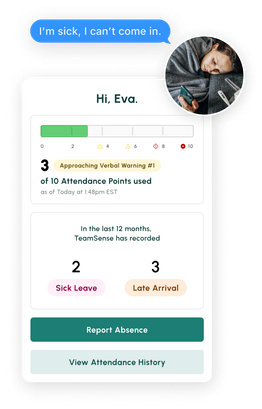Fix the root cause of No-Call No-Show with help from TeamSense
In today’s workplaces, employee self-service (ESS) portals make it easier for employees to access pay, benefits, HR policies, and more. An ESS portal also enables employees to submit information such as time-off requests and sick day notifications without direct intervention by HR or their manager. On top of that, they serve as an important efficiency to save your HR team countless hours by providing access to the most commonly requested resources.
It can be challenging for industries like manufacturing, construction, and hospitality to offer an ESS portal that employees can easily access. By providing an ESS portal that is easy to navigate and accessible from anywhere, you can empower your hourly employees with self-service access to a range of company resources and policies.
9 Things to Include in Your ESS Portal:
- Payroll Login
- Time and Attendance Information
- Benefits Information
- Workplace Policies and Employee Handbook
- Company News
- Job Openings
- Upcoming Training
- Engagement Events
- Employee Recognition
What is an Employee Self-Service Portal?
An employee self-service portal is a technology that allows employees to obtain employment information, forms, and other resources.
Employees can access ESS resource portals to view pay stubs, benefits enrollment information, company news, and additional information. As a result, they have become increasingly popular in organizations across a range of industries.
According to the 2020 Sierra-Cedars HR Systems Survey, 66 percent of organizations use an ESS resource portal for HR documents and resources. An additional ten percent said they were considering adopting one within the next 12 months.
Besides empowering employees to access useful employment information, an employee portal frees up HR and managers, so they are no longer solely responsible for providing employment information and answering routine employee questions.
When you have an interactive ESS portal, employees can take actions like:
- Request time-off
- Submit employee survey responses
- Report a safety incident
- Apply for internal job openings
9 Things to Include in Your Employee Self Service Portal
An employee portal should be flexible enough to include all the HR and payroll resources employees seek while also allowing you to add new resources and make updates to the information already there.
To create an ESS portal tool that enables your team to access their own employment information, give them access to important resources like:
- Payroll Login: Include access to pay stubs, federal and state W-4 forms, and annual W-2 forms.
- Time and Attendance Information: Allow your team to see shift schedules, time and attendance policies, and information about eligible leaves.
- Benefits Information: Include links to open enrollment documents, current enrollment information, and new dependent and beneficiary forms.
- Workplace Policies and Employee Handbook: Let your employees quickly access their employee handbook, safety procedures, and holiday schedules.
- Company News: Include your hourly team members in company updates, new hire announcements, and current openings.
- Job Openings: Career growth is at the top of mind for many employees, as well as hiring new team members for employers. Accomplish both goals by readily sharing your openings with your team.
- Upcoming Training: Keep your team up to date for upcoming training. Either as a way to increase their skill set and level up in your organization or to meet their annual training requirements. Either way, it is important to let you team know when the events are happening to keep participation top of mind.
- Engagement Events: Your team should be able to provide information back to you through things like employee pulse surveys
- Employee Recognition: Improve your workplace culture by creating a space for team shoutouts and employee recognition.
ESS Portals are a simple way to keep your team informed and connected to important employment information and empower employees to access the information they need when they need it.

Is your call-in process terrible? Text reduces no-shows and absenteeism by up to 40%.
Don't believe us? Check out this case study to see how this 3PL benefited.
About the Author

Sheila Stafford, CEO of TeamSense & AI in HR Innovator
As CEO of TeamSense, Sheila Stafford is at the forefront of transforming HR for frontline teams through AI-driven solutions. With a commitment to enhancing employee relations and simplifying workforce management, Sheila leads TeamSense in pioneering advancements that empower both frontline employees and HR teams. Her visionary approach combines cutting-edge technology with a thoughtful focus on enhancing human connection; Sheila strategically implements AI where it adds the most value while recognizing the critical role of personal interaction and ensuring that human engagement remains central when it matters most. Under her leadership, TeamSense is redefining how companies support and engage their frontline teams for a more connected, efficient workplace.





